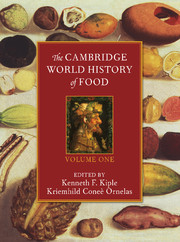Part II - Staple Foods: Domesticated Plants and Animals
Published online by Cambridge University Press: 28 March 2008
Summary
Part II, with its almost 60 chapters that concentrate on staple foods (most of the fruits are treated in Part VIII), constitutes the largest portion of this work. Yet the space devoted to it seems more than justified in light of the immensity of the effort that humans have invested in domesticating the plants of the fields and the animals of the barnyard. In the case of plants, the effort began with the harvesting of wild grains and roots, which probably became a seasonal activity for some hunter-gatherers as the last Ice Age receded and the large mammals – mammoths, mastodons, giant sloths, and the like – were embarking on their journey to extinction. The next leap – a giant one – was from locating wild grains for harvest to planting them in permanent places and then tinkering with them and the soil so they would do a better job of growing.
Wolves were domesticated to become dogs toward the end of the Paleolithic. Like their human companions, they were hunters. But with the beginning of farming, a host of other animals followed them into domestication. In the Old World, goats and sheep, which fed on wild grasses but had no objection to domesticated ones, were probably initially perceived by early farmers as competitors – if not outright thieves – to be fenced out or chased away. But with the precedent of dog domestication to guide them, people began to capture these ruminants and eventually raised them in captivity. In many cases, the purpose seems to have been a supply of animals close at hand for ceremonial sacrifice. But even if meat, milk, hides, hair, and wool were secondary products at first, they were, nonetheless, important ones that quickly rose to primacy. Pigs, cattle, water buffalo, horses, even camels and, later on, chickens may have also been initially sought for sacrifice and then, after domestication, exploited for their other products, including labor and transportation.
- Type
- Chapter
- Information
- The Cambridge World History of Food , pp. 73 - 74Publisher: Cambridge University PressPrint publication year: 2000
- 1
- Cited by

